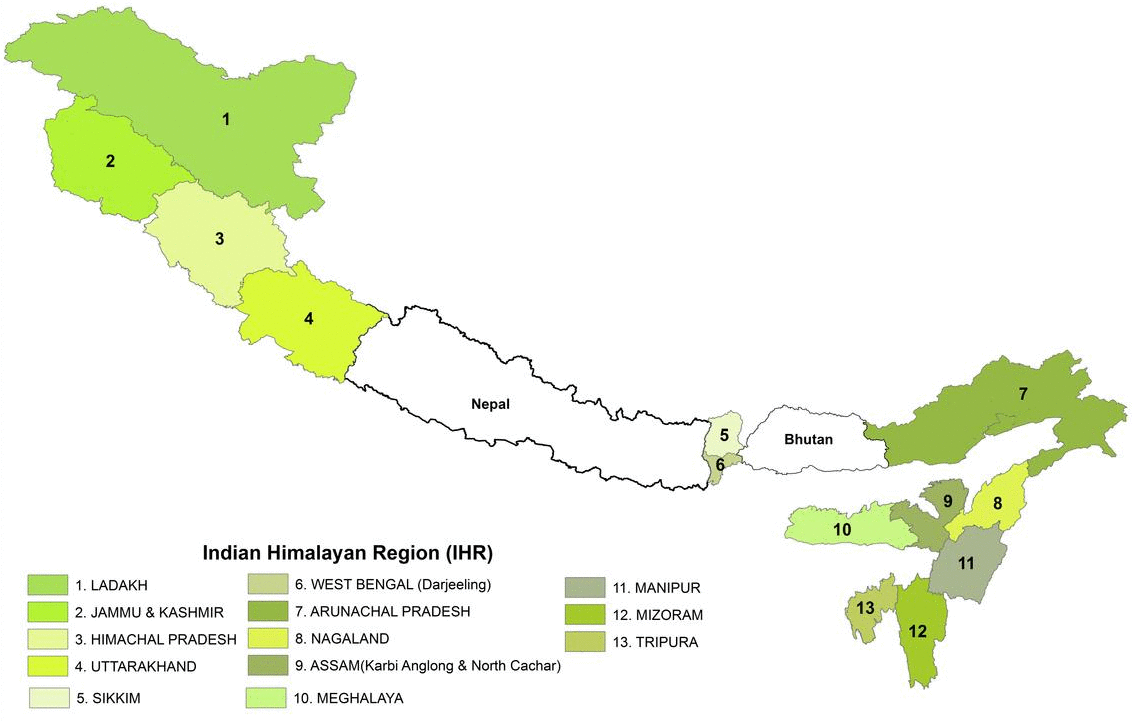
 |
|LiFE-Lifestyle for Environment|
|
|LiFE-Lifestyle for Environment|
|
Executive Summary
|
|
The Himalaya, a highly complex and diversified mountain system both in terms of biological and physical attributes, is considered a life support system for millions of people in uplands and much more in lowland areas of India. It acts as climate regulator for much of Asia and is globally recognized for its sacred, spiritual and philosophical values.
While the richness and uniqueness of bio-physical and socio-cultural diversity and rich heritage of Indigenous Knowledge and Practices (IKP) have earned the Himalaya a global recognition, this system being young and geotectonically active remains inherently unstable, fragile, and prone to natural disasters. Also, the vulnerability of this mountain chain towards human-induced disturbances is now well established. Therefore, being special and change sensitive system, and more importantly due to its life support values, the Himalaya deserves a special attention. It requires conservation and development interventions in sustainable manner, which do not ignore the imperatives of mountain specificities. This, therefore, calls for evolving new paradigms of long-term conservation and sustainable development that help restoring intricate balance between economic interests and ecological imperatives in the region in particular and country in general. Recognizing the above and realizing that the Himalaya is important for Ecological Security of the country, the Government of India attaches highest priority to protect unique but highly fragile Himalayan ecosystem. The National Mission on Himalayan Studies (NMHS), a Central Sector Grant-in-aid Scheme, therefore, targets to provide much needed focus, through holistic understanding of system's components and their linkages, in addressing the key issues relating to conservation and sustainable management of natural resources in Indian Himalayan Region (IHR). The ultimate goal is to improve quality of life and maintain ecosystem health of the region to ensure long- term ecological security to the country. As the Mission specifically targets the Indian Himalayan Region (IHR), the jurisdiction of NMHS includes 10 Himalayan states fully (i.e., Arunachal Pradesh, Himachal Pradesh, Jammu & Kashmir, Manipur, Meghalaya, Mizoram, Nagaland, Sikkim, Tripura and Uttarakhand) and two states partially (i.e., hill districts of Assam and West Bengal). With a broad Vision to support the sustenance and enhancement of the ecological, natural, cultural, and socio-economic capital assets and values of the IHR, the mission is to launch and support innovative studies and related knowledge interventions. The NMHS envisages to work towards a set of linked and complementary goals to: |
|
| The Mission strategy is to focus on enhancing livelihoods of local communities, in line with the National Environment Policy, 2006 of the Government, with a basic premise that the most secured and effective basis for conservation is to ensure that people dependent on particular resources obtain better livelihoods from the act of conservation than from the degradation of the resources. The NMHS has identified a list of 7 Broad Thematic Areass: |
|
1. Water Resource Management 2. Livelihood Options and Employment Generation 3. Biodiversity Conservation and Management 4. Skill Development and Capacity Building 5. Infrastructure Development 6. Physical Connectivity 7. Handling of Waste
|
| The objectives of the Mission include the following: |
|
|
The core philosophy is to enhance the focus and fund for supporting demand- driven research and technological innovations along with institutional strengthening and capacity building. Overall attempt is to work towards coordinated policies, duly informed decisions based on empirical evidences and best practices, thereby providing enabling environment for innovations and multi-stakeholders engagement in protection of Himalayan ecosystems and socio-economic development of the local communities. Towards achieving the objectives, the Scheme follows a systematic approach by way of supporting Studies, Pilots and Interventions under three categories: |
|
|
While clear-cut guidelines are in place for developing projects under these categories, the Mission lays greater emphasis and preference to innovative and multi-disciplinary projects that adopt landscape based/level approach and may have trans-boundary linkages. It is further underlined that the pilots/projects having clear policy dimensions and knowledge outcomes would be given higher weightage. The Scheme, in addition, also envisages facilitating knowledge building in IHR Institutions by way of: |
|
|
The Scheme is implemented by the Ministry of Environment, Forest & Climate Change (MoEF&CC), and it will have its nodal and serving hub with G.B. Pant Institute of Himalayan Environment & Development (GBPIHED) with a fully dedicated Project Management Unit for the NMHS. To guide the overall implementation, a Steering Committee, Chaired by the Secretary MoEF&CC, is in place. Also, a Scientific and Technical Advisory Group (STAG) with wide base representation of Stakeholder Groups and under the Chair of Additional Secretary, MoEF&CC, has been constituted. Recognizing that the Indian Himalayan states will have differential needs and priorities to be addressed through in-depth studies, representation of all Himalayan States has been ensured in STAG so as to provide equal opportunity to such needs/priorities of states to be covered under the NMHS.
|

|

|